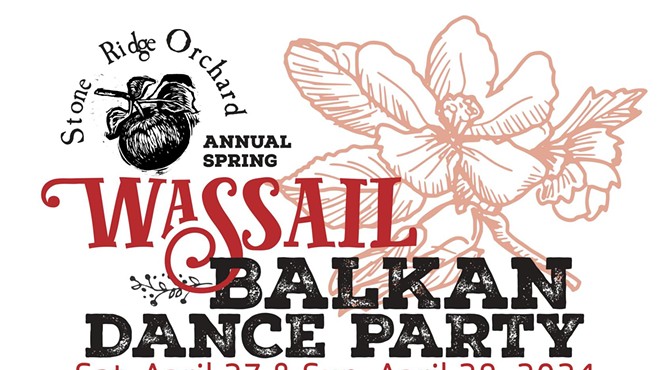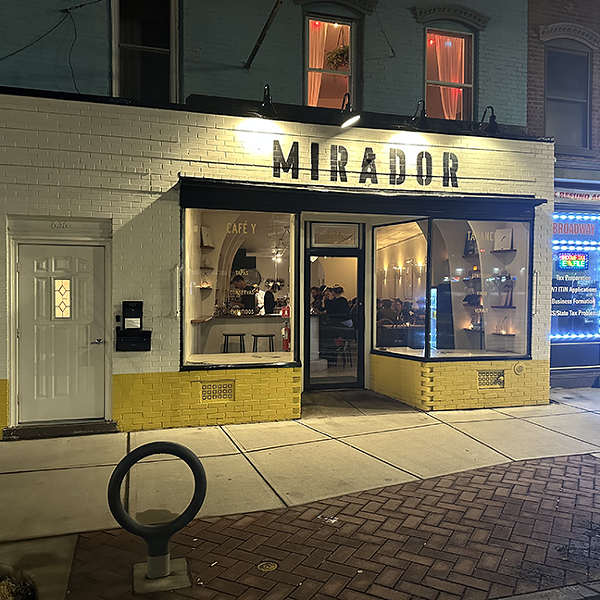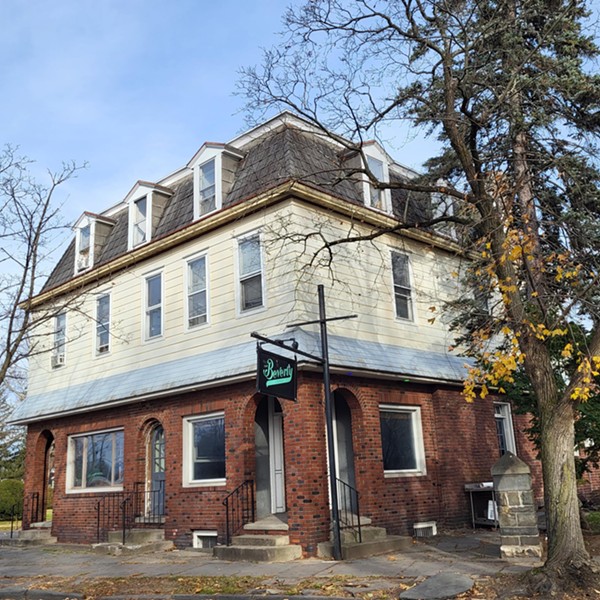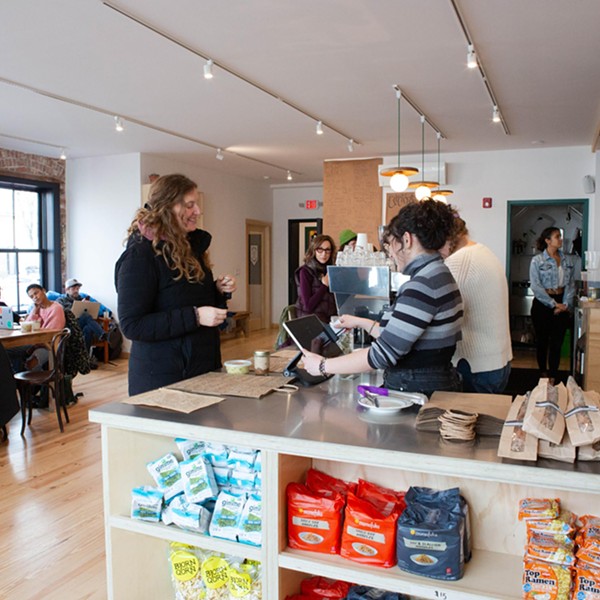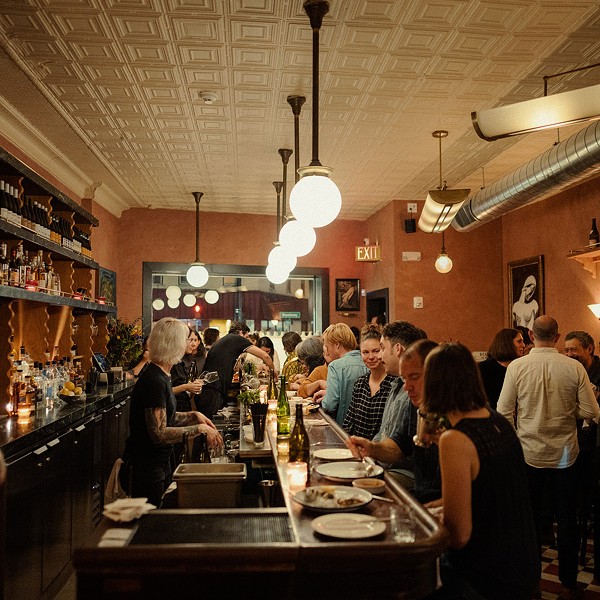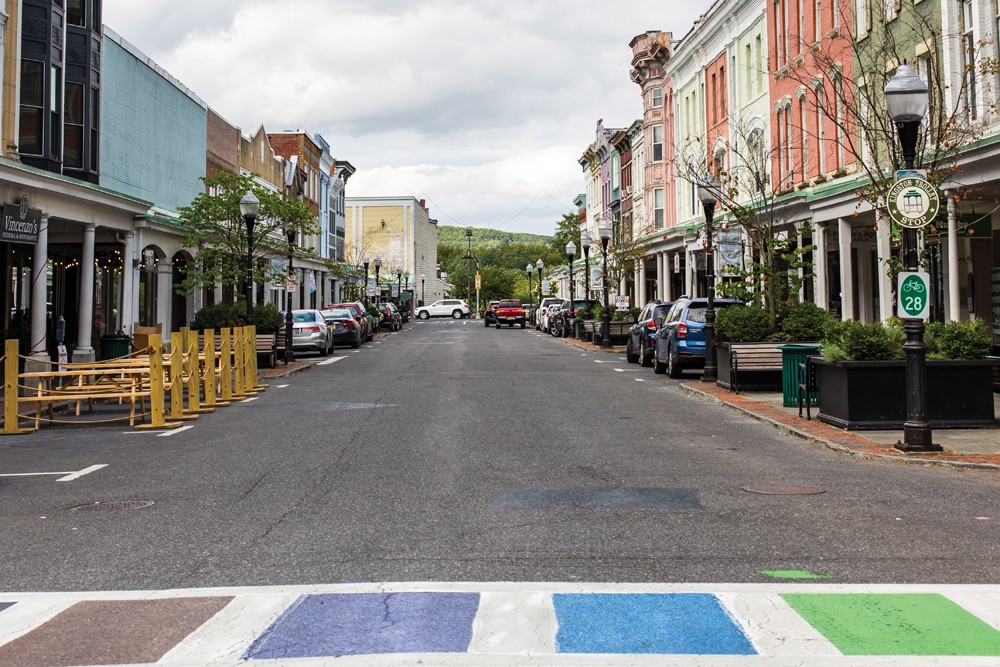
We have the fastest-growing real estate market in the country right now," says Jared Ashdown as we enter Rough Draft Bar & Books in Kingston. "It's not just for people who want to escape the city. It's for people who want a second home or that Airbnb action."
It was early October, and Ashdown and I were on the tail end of an improvised tour through Kingston, a working-class city now home to the fastest rising home prices in the nation, according to a recent report by the National Association of Realtors. Desirable for its affordability, diversity, historic buildings, and direct bus line to New York City, the City of Kingston and Ulster County have seen a large influx of New Yorkers this summer because of the pandemic, which has challenged Kingston's affordability: Affluent New Yorkers, accustomed to a higher cost of living, have been willing to pay a premium in Kingston to escape a city under lockdown. At the same time, local residents, many of whom work in the service industry, lost their jobs. In April of this year, Kingston lost approximately 3,300 leisure and hospitality jobs; in the last year, the Hudson Valley region reported 33,600 job losses in the leisure and hospitality industry.
By July, Kingston's hospitality industry had regained these lost jobs and, in September, the number of hospitality jobs had even exceeded pre-pandemic levels, perhaps to accommodate the recent influx of COVID-19 refugees. Although Kingston was able to gain back these lost jobs, the question now is whether or not it can gain more affordable housing options.
Although Kingston was able to gain back some of its lost jobs, the question now is: Can the city house its less-affluent residents?
Beginning in Midtown, a predominantly Black neighborhood where Ashdown grew up and currently resides, we drove through dilapidated side streets and saw as many real estate signs as political signs. On Ashdown's own block, a handsome two-story Victorian on the corner with a "For Sale" sign had a "Sale Pending" sticker slapped on it. Ashdown, 25, has deep family roots in Kingston. His mother, who is Black, has ancestors dating back to the early 18th century. His father's side of the family is Italian and arrived in the 1950s to work in the waterfront brickyards.
In Uptown, a more affluent, whiter neighborhood, we entered Rough Draft Bar & Books, where Ashdown exchanged pleasantries with Brett, our "bibliotender," and then asked Brett to share the story of why he had to move in the early weeks of a pandemic and economic recession.
Market Boom
In March, just as the pandemic was upending daily life, Brett's landlord texted him. "I'm selling the place and the new buyer wants to move into your apartment," he wrote, and gave him six weeks to vacate. Brett had lived there for two-and-a-half years and wanted to maintain what had been a good relationship with his landlord, so he moved out and found a one-bedroom apartment for $1,400 a month. Still, his new place was significantly smaller and more expensive than his previous apartment, a three-bedroom where he paid $1,350 a month.
"What really ticked me off was my landlord said, 'We got a good deal.' I really wanted to text him back and say, 'I'm not getting a good deal.'"
"Is this really the time to be talking about a good deal?" Ashdown chimes in. Etiquette aside, profiteering off a pandemic, however fraught, has become a cottage industry for landlords in Kingston as affluent New Yorkers seek to escape crowded and cramped living conditions in the city for open space and safety in nearby smaller cities.
Compared to 2019, home sales in Kingston have jumped 18 percent in price and now average around $276,000. The growth has been so dramatic in Ulster County that home prices have notably increased even in the short timespan between mid to late summer. On July 1, the median home sale was $318,000; by mid-August, that number had leaped to $345,250. "Housing in general is already in short supply in the Hudson Valley," writes Joshua Simons, a senior research associate at the Benjamin Center in SUNY New Paltz.
Though data is scarce because these developments are so recent and closing a home can take months, anecdotal reports from real estate agents and locals describe a gold rush for upstate property: buying property sight unseen, bidding wars, and cash offerings 20 percent above the asking price. But everyone I spoke to was quick to note this recent surge in the housing market merely accelerated pre-existing trends that sociologists Simons and Leonard Nevarez summarized as the "Brooklynization" of the Hudson Valley. The pandemic simply poured rocket fuel onto the fire.
IBM and Economic Fallout
The most recent flashpoint to understand Kingston's economy and housing market is when IBM laid off thousands of workers in the early 1990s. The technology company was the "economic anchor in the Hudson Valley throughout the latter part of the 20th-century," says Simons, who lives in nearby Esopus.
"IBM isn't merely a prime mover of the economy here," begins a 1991 article in the New York Times about IBM's economic footprint in the Hudson Valley. "IBM is the economy." At the peak of its presence upstate, the computer giant employed more than 46,000 people living in Dutchess, Westchester, and Ulster counties. In 1985, IBM employed 7,000 people alone in its major manufacturing and development center in Ulster County. But in 1993, IBM conducted mass layoffs throughout the region, culminating in the closure of the Kingston facility.
This economic devastation brought on by the closure of IBM's plant was compounded by law enforcement crackdowns on crime and the crack epidemic, which gutted small city centers by the late 1990s. Divestment from city centers was coupled with governments and police departments who, then as now, focused on containing issues like crime and criminalizing issues like addiction, rather than treating them as social problems worthy of investment.
Uncovered Gem
"In an attempt to remake the economy, [the Hudson Valley] shifted more toward hospitality, tourism, antiques," says Simons. In Kingston as elsewhere, the pivot toward tourism led to a service-based economy, which rarely creates well-paying jobs, can be subject to slow seasons, and can have a high turnover rate. "Waiters and bartenders make good money," Simons notes, "but the longevity of a career in that industry is not there."
Hudson and Beacon are the poster children for what proponents call an economic renaissance, a pivot away from manufacturing and an embrace of arts-driven tourism. "By contrast to Hudson and Beacon, Kingston was still sort of hidden," says Professor Leonard Nevarez, who chairs the Sociology Department at Vassar College and lives in Rhinebeck. "The pace of change was slower, it didn't have a signature museum or attraction, [but] the pace of change started to accelerate in the last couple years," and, today, "Kingston is the frontier of affordability in a hip city."
In a paper subtitled "The Racialized 'Brooklynization' of New York's Hudson Valley," Nevarez and Simons apply a cultural analysis to gentrification, which is usually framed more strictly in economic terms, to examine what role cultural amenities have played in the transformation of the Hudson Valley over the past two decades. People are "coming not just for cheap property or investment property, but for a real lifestyle experience that you have to understand through cultural amenities," Nevarez tells me.
In the case of Kingston, Nevarez and Simons argue its greatest amenity was its "reputation as a 'hidden' small city with historic architecture and contemporary cool." In other words, Kingston's marketability traded on being a hidden gem. This hidden aspect, coupled with Kingston's roots as a working-class city, promised an "authentic" upstate experience. Examples abound in Kingston: the artful murals around the city from the O+ Festival; the arts manufacturing sector in Midtown. As Nevarez stressed, this cultural aspect is as much a factor as economics when people leaving New York City decide where to go.
Moreover, the pandemic has upended what people value. Many now prioritize open space and safety over, say, museums or nightlife. While Kingston does have a vibrant arts scene—Ashdown himself is a musician and had a studio session later that evening—it is also a gateway to the Catskills. "The air, the water, the food": these top Ashdown's list of reasons why he keeps returning to Kingston after spending brief stints abroad, in the city, and a few years in Woodstock.
The Impact of Airbnb
Kingston has blown up since Nevarez and Simons authored that paper, just a year ago. What, exactly, put Kingston on the map? While it is difficult to pinpoint cause and effect, Nevarez suspects Airbnb played a role.
The real estate market in Kingston has been throttled for years, in part because there are few new housing developments, but also because the local economy has been reshaped by Airbnb. In 2018, Airbnb generated $24.4 million in revenue in Ulster County bookings, nearly triple that of any of the other 55 counties north of New York City. Ulster County had double the number of Airbnb guests (149,800) and nearly double the number of listings (2,500 listings among 1,800 hosts) of any other county.
In 2019, Airbnb listed the Hudson Valley and Catskills as one of its top trending destinations worldwide. The only other US destination was the Smoky Mountains, the most visited National Park in the country. Citing outdoor and cultural amenities as major lures, the report states that, between 2017 and 2018, the Catskills and Hudson Valley saw a 100 percent year-over-year increase in bookings and a 130 percent year-over-year increase in searches.
Airbnb declined to share 2020 data for Ulster County and Kingston, but a quick search in its directory shows 109 listings in Kingston, 83 of which are for an "entire place." When Rashida Tyler, founder of the REAL Kingston Tenants Union, talks about the vacancy problem in Kingston, this is part of that problem. Here are 83 homes withheld from the residential market in favor of visitors who may stay for a weekend or a week. As of 2018, Airbnb listings accounted for three percent of total housing units in Ulster County.
Increasingly, however, these visitors are staying for weeks or even months at a time, with the pandemic having unmoored knowledge workers from office life. Airbnb reported that upstate New York, specifically Utica, Saratoga Springs, and the Adirondacks, were among the fastest-growing locations for long-term stays, meaning 28 days or more.
Will these moves be permanent? It's hard to tell, but one in three remote workers said they would move to a new city or state if remote working continued according to a recent survey jointly conducted by the New York Times and Morning Consult.
For Tyler, Airbnb is the latest tool in a long history of extraction that has taken resources from the city center and neighborhoods like Midtown, and brought them to the periphery. When we spoke over the phone, Tyler had recently finished polishing a speech she planned to give at an anti-gentrification rally the following week. In Tyler's view, the Midtown of today reflects "divestment of resources from the city, white flight, and a funneling of people who lacked resources to one area of the city." This is the result of a "policy of containment" wherein discrimination in housing and employment conspired to create a segregated Kingston.
"I'm not totally against Airbnb," Tyler hedges. "If you have a room you can rent out occasionally to earn extra income and pay your mortgage, that's okay. But that's not what's happening. What's happening is an unregulated industry taking over homes that could be places where people live year-round." Although Ulster County does levy a two-percent occupancy "bed tax" on all hotels, motels, and short-term rental properties, only about 75 percent of Airbnb hosts comply with the ordinance and are registered with the Department of Finance. County officials estimate as much as $200,000 was lost in occupancy tax revenue in 2019.
For its part, the Kingston Common Council has at least seemed to recognize that Airbnb has become a problem: In October, a special housing committee set a deadline to present proposals for regulating short-term rentals to the entire council by the end of the year. "This would be one way to free up some units that have been chronically Airbnb'd," Mayor Steve Noble told me in a phone conversation.
The Media's Role
The media, perhaps unwittingly and certainly uncritically, has been a publicity arm for the Hudson Valley's pivot toward a tourist economy. A quick survey of New York Times headlines shows how the paper has covered developments in the Hudson Valley in the Travel, Arts, and Real Estate sections. Its framing suggests a language of opportunity, rather than one of extraction and gentrification. "Beacon, NY: Quaint City Rediscovered" and "Hudson, NY: An Elegant Transformation" are two representative headlines from the last decade.
More recently, stories have been told from the point of view of "COVID-19 refugees." An article authored by someone who moved to Kingston in 2016 drew the ire of many locals for being tone-deaf and uncritical of their own role in gentrification, which has impacted many residents firsthand, including Rashida Tyler.
Like Ashdown, Tyler is a native of Kingston with deep family roots that, in her case, date back to the 1930s when her grandparents arrived as part of the Great Migration, the period between World War I and the 1970s when millions of African-Americans fled the Jim Crow South.
Tyler first experienced the harms of gentrification at the age of 16. "My family had been through a lot of apartments, and we finally found a place we could afford in the Rondout section of Kingston—a beautiful, brick Victorian," she says. Her family had a great relationship with the landlord, but when he sold the building to someone from Westchester, the new landlord's first action was to present the family with an eviction order. "We had to leave because he wanted something we had," Tyler says. "Because it was in a certain location."
What Can Be Done?
"By the time you start talking about gentrification, it's too late to stop gentrification," says Simons in a sober assessment of the current housing situation. "The strategies at this point really need to focus on harm reduction overall."
In the current pandemic economy, millions of renters are at risk of eviction. In Ulster County, 41 percent of households either live in poverty or earn more than the Federal Poverty Line but less than the basic cost of living for New York State. In Kingston, that figure jumps to 57 percent.
Recognizing the immediate need for more affordable housing, Ulster County Executive Pat Ryan expanded Kingston's land bank for workforce housing to be county-wide, assembled a committee to advise on what's driving the shortage of affordable housing, and bolstered funds for the Emergency Rental Assistance program by reallocating $150,000 from the Housing Rehabilitation Program.
For Mayor Noble, the problem of affordable housing is really a question of supply and demand. To this end, Noble was encouraged by two new affordable housing developments—Energy Square, a 57-unit building, and Landmark Place, a 66-unit building intended for seniors—as well as the Kingston City Land Bank releasing a request for proposals to redevelop three single-family homes. The former county jail will also serve as a site for new affordable housing, with 160 units total, half of which are intended for seniors. Construction will likely not start at the former jail site until 2022.
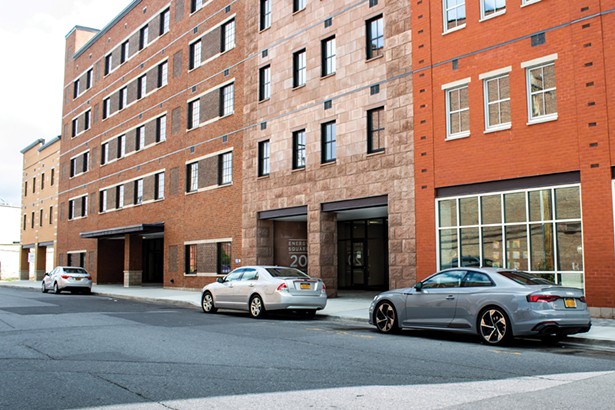
In addition, Mayor Noble has proposed a 10-percent affordable housing requirement on all new developments, which he described as a "temporary stop-gap measure." "Ten percent is at least a first step, while we look to rewrite our zoning codes," he says, which were authored in the 1960s. (Kingston housing nonprofit RUPCO has partnered with the city to launch the Kingston Rental Assistance Program, which will provide up to three months rental arrears for low and moderate income families. Applicants must be able to document a direct impact by COVID-19 by a reduction or loss of income. The application deadline is December 31.)
In May of this year, Tyler and the REAL Kingston Tenants Union joined forces with several other community organizations to form the Ulster County Coalition for Housing Justice. In the short term, Tyler is focused on providing immediate housing through rapid renovation programs and she's in talks with City Council about donating or selling land for "tiny homes." "We need non-congregate housing options this coming winter for the unhoused and low-income," says Tyler, referring to the increased risk of COVID-19 as individuals spend more time indoors. Tyler knows of two individuals who have been living out of their car because they have health conditions and are wary of entering a shelter for fear of contracting the virus. Long term, Tyler is set on introducing a number of housing policy reforms, such as a residential vacancy tax.
Since IBM left in the early `90s, Tyler has seen the city of Kingston "being marketed like the Wild West: Build what you wanna build, scrap the people." This is best represented by the Kingstonian, a mixed-use development with 129 apartments (14 of which are earmarked for affordable housing units), a boutique hotel, and a high-end retail storefront. "The rents are pegged for people who aren't here yet," Tyler says.
For her, this belies a more significant problem: the exclusion of Kingston residents from plans and discussions surrounding future development. "That is the core problem with development in Kingston and in gentrified areas," Tyler says. "These plans are 20 years out, but the people are not privy to them."
"The faces that I grew up seeing either aren't here or are about to be gone," Ashdown tells me as we seated ourselves on a bench outside the Senate House and under the watchful eye of a Sojourner Truth mural. "It's bittersweet—the thing you love and cherish the most is now this co-opted thing. Instead of moving out to pursue something, I feel like I'd need to move because I don't have a chance to live here anymore."








